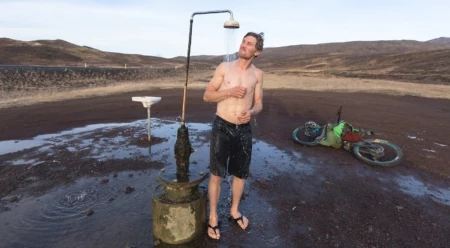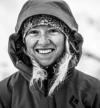Mud, Sheep, Fish, Trail
The raw potential of mountain biking in Iceland’s Westfjords.
Mud and rain speckled my lenses. I squinted at the mucky, rock-strewn road in fading light and gripped my handlebars tighter. Focus. Exhale. Let go. At the next corner, Carston and Eric are stopped. Odd, I don’t usually see them until the bottom. Brakes shrieked in damp protest as I pulled up to a gooey red mess spilling across Eric’s nose, mouth and chin. “Are my teeth still there?” he asked through swollen lips, shivering under the evening drizzle.
We’d just spent the day biking in a remote farm valley in Iceland’s Westfjords, piecing together sections of sheep trail. Sprawled across the springy, memory-foam moss, Eric had happily stuffed his cheeks with blueberries, dribbling juice while extending brimming handfuls toward Carston and me. We were minutes from the car when a mud hole swallowed his front wheel axle-deep. After futile attempts to seal the triangular gash cutting through his upper lip with Steri-Strips—the glue dissolved instantly in the rain—we piled into the car and headed for the hospital to get stitches.
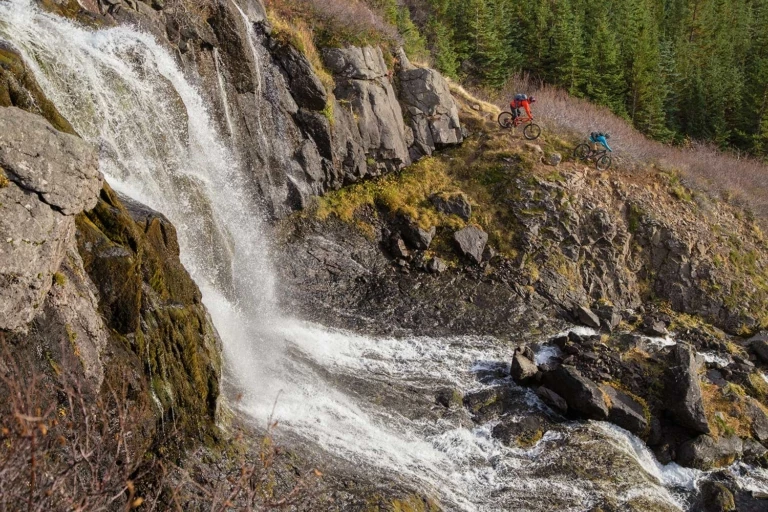
Sunshine, like mountain bike trails, is rare in
the Westfjords but worth the chase. Eric and Carston make good use of the rays and a loop of hiking paths—rudimentary yet rideable—during their continued search. Photo: Mary McIntyre
For an hour and a half, we wound along coastal roads, hugging the edges of the dark fjords. The road dove into the mountains, passing through a 4-mile-long, single-lane tunnel before the lights of Ísafjörður glimmered ahead. It was the Westfjords’ biggest town and only community with medical facilities. The on-call doctor arrived in three minutes. He sewed the wound up slowly, with frequent audible, inhaling exclamations, a common Icelandic articulation that was especially unnerving in this situation. He sent us home, calling out, “No biking, of course!” as our three muddy figures disappeared down the fluorescent-lit hallway.
Yeah, right.
“The mountain biking scene in Westfjords is at an early stage,” friend and Ísafjörður local Vidar Kristinsson wrote several months earlier, “I promise you it will be a suffer-fest and rocky.” I assumed, since he’s new to biking, that the riding might be smoother than his ringing endorsement suggested, and we packed our bags to explore the new trails.
The Westfjords comprise nearly 9,000 square miles of jagged coastline; a spur of volcanic mountains rising 3,000 feet above glacially carved fjords jutting into the North Atlantic. Despite being inhabited for over a millennium, it remains an isolated, wild place, with a population of 6,870 people spread between tiny communities and single-family farmsteads. Traditional fishing villages have been in decline since the 1980s, when seafood industry giants bought out individuals to create fewer, larger companies in the country’s urban hubs. But recently, a growing interest in outdoor recreation has city dwellers moving back. Similarly intrigued, we took to explore the biking potential in the region’s windy, wet weather.
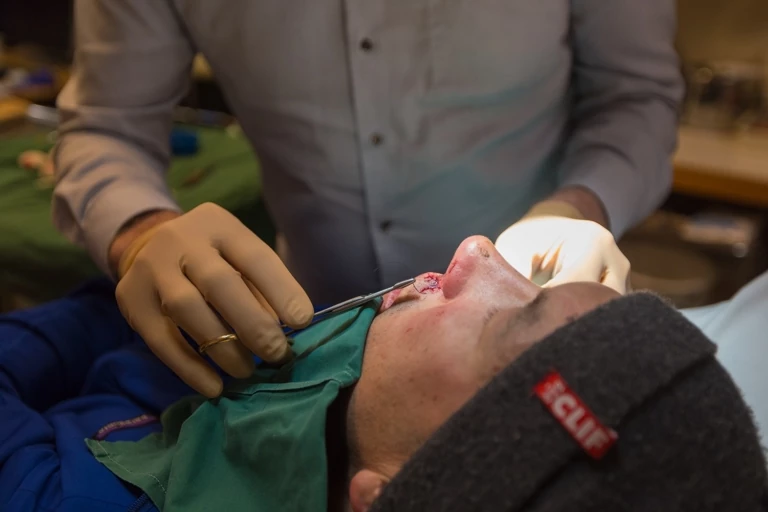
After sinking his front wheel hub-deep into a muddy pit on an old farm road, Eric was “whisked” (one and a half hours) to the nearest hospital so the doctor could stitch the gaping flap in his lip. He was then instructed to take a few days off, which he most certainly did not. Photo: Mary McIntyre
I soon realized that Vidar’s trail descriptions were terribly accurate, and I worried I’d invited my friends here under false pretenses, as we struck out on finding more than 50 feet of continuous trail day after day. Spirits were low and the rain incessant. That is, before we met Óliver Hilmarsson. A recent Ísafjörður transplant, he came to work as an avalanche forecaster in town. Our host introduced us to the Vikingly tall, salt-and-pepper-haired biker. “When I moved here, I wanted to go biking—I searched for trails but didn’t find any,” Óliver explained. “But I saw these wooden ramps that someone put on the hill above town years ago to make a bike track. So I started there, and the trail got longer and longer.” The following day was the first (and the one and- only) good weather in the forecast, and we used it to ride the one-and-only bike trail in town: Óliver’s Trail. This brand-new, built-this-summer track is my salvation.
We met Óliver just after sunrise. It was 10:30 a.m. Low clouds burned away, revealing blue sky and a bright sun we hadn’t seen in days. “In North Iceland, we had actual bike trails,” he joked as we started off. Pedaling up a gravel road that connected Ísafjörður to the nearby town of Bolungarvík before the tunnel was built, Óliver explained the trail’s inception, “I’d come after work, a few hours every night. We had a rule: If you bike the trail, you have to extend it 50 meters (164 feet).” A steady climb brought us to the vast highlands where roads spider-web out to towns along the remote west coast. “We felt like we should get permits, so we wrote a letter to the town,” he continued, “and they thought it was pretty cool. Mountain runners have been using the trail also. This valley is already a recreational area so it fits into the town’s plan.”
Patches of snow from the first winter storm dotted the plateau, but it was solid enough to ride across and Óliver led us down his summer project. Weaving down the singletrack below, Carston and Eric played on jumps and rock drops as the trail meandered through barren, tundra-like landscape. Fin-shaped mountains rose above us, zebra-striped with snow against black rock. It was late October, and the sun was low in the sky, barely rising above the mountains. Thick, golden light cast long shadows across lakes and fluoresced against soft green moss.
Stopping at a shoulder-high cairn—an ancient, lichen-coated waymarker from the time of foot and horse travel through these mountains—Oliver pointed out plans for future trails. “The community is behind it, 10 full-suspension bikes were bought this summer. I know two young kids working to save money for bikes. Everyone is helping build. The ski resort is good in the winter, but we need summer activities, too.” Steep rock walls lined the deep blue fjord, which bobbed with small fishing boats. The lights of town glowed in early dusk. Oliver took off to pick up his kids from a birthday party while we enjoyed the rainless evening, hiking up to re-ride and fine-tune sections as darkness fell. We were the only ones out there.
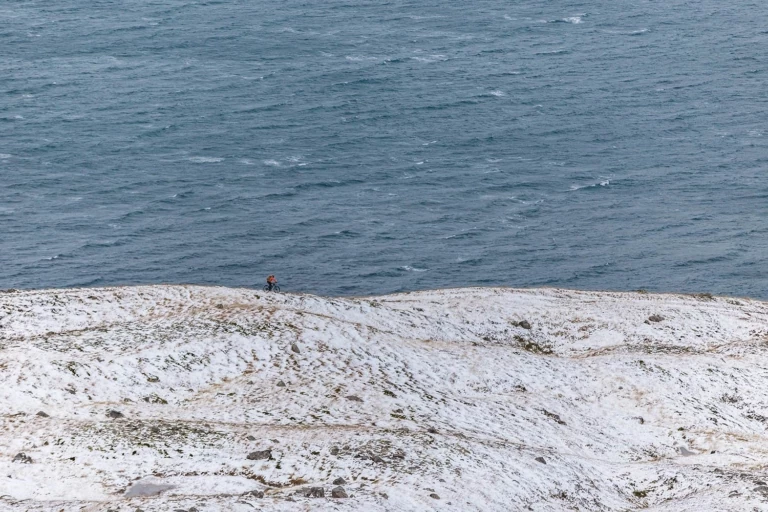
After a foot of snow fell overnight, Carston stubbornly sticks to biking, following an old, windbattered road up the oceanside plateau. Photo: Mary McIntyre
This region has a 1,000-year history of fishing and subsistence farming. It’s only recently a place of towns and jobs and leisure activities. It’s experiencing a huge transition, and the groundwork for outdoor recreation is being laid now. People taking initiative have the opportunity to shape their community’s future. “In Iceland, everyone is an entrepreneur,” a friend told us. He had just started an adventure mountain biking company.
Back in town, I excitedly told a friend that we rode Oliver’s Trail, having the best day of biking yet. He surprised me, countering, “Oh, it’s Oliver’s Trail, is it? I put hours of work into it this summer.” He cracked a smile, joking, to my relief, but I realized the entire community was invested in this and in the trail network as a whole. On our way home, we pedaled to the fish shop where Caury the fishmonger wrapped up fresh arctic char and recommended lightly cooking it in butter, herbs and garlic. When we explained that we were here to mountain bike, we were greeted with the Icelandic inhaling exclamation, “It is October …” We nodded gravely; it wasn’t the first time we’d been reminded that winter’s coming. Ísafjörður was about to lose the sun until February. There was a nip in the air and the town was settling in for “cozy time”— darkness, tea and candles.
Before we left, Óliver showed us an old horseback mail trail that his friend recently found on Google Earth. He had yet to ride its 8-mile descent from the upper plateau to a nearby fishing village, but it was enough to get him fired up for next summer’s exploration. We were a few years early for a true bike scene here, but there was something raw and exciting about seeing a place’s earliest stages of development and discovery. There were so many sheep tracks and forgotten routes crossing these mountains from its millennium of human inhabitation that the potential for resurrecting old trails was as huge as for building new ones. Fresh-caught fish, a network of Viking-worn paths and the friendliest community I’d stumbled into while traveling were all worthy of a return visit. Besides, by the time we returned, there would definitely be more than one bike trail in town.
This story is featured in the September 2018 Patagonia Catalog.
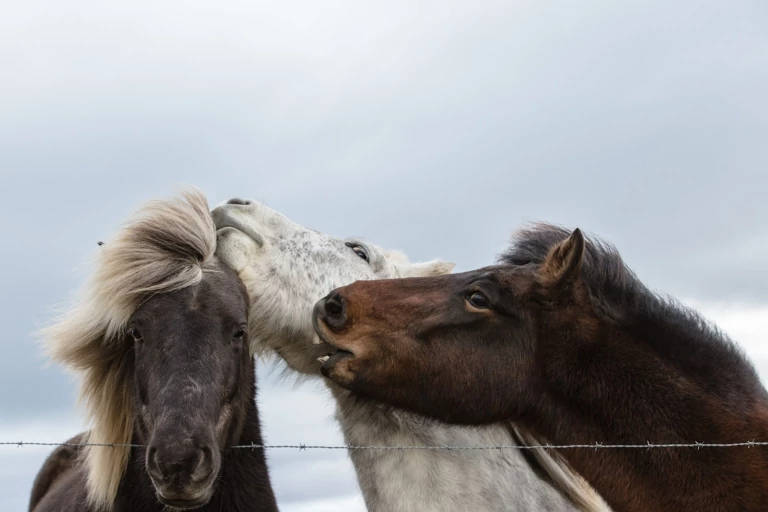
Scratching an itch is easy when your buddies are in on it. Icelandic horses, first brought to Iceland by Viking settlers in the late 800s, echo the windswept landscape of
the Troll Peninsula. Photo: Mary McIntyre
